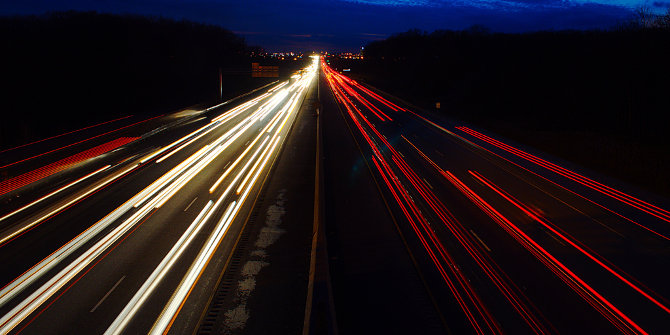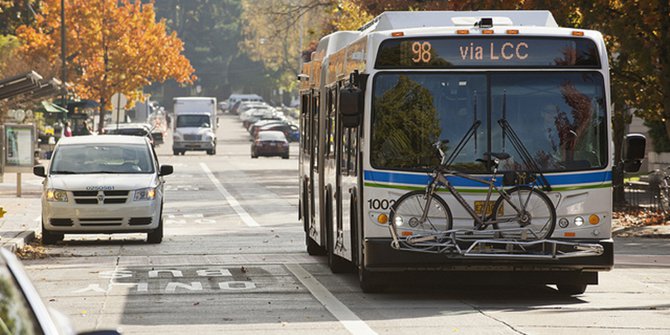 The vast majority of trips made by Americans every day are by car, and yet over the past decade, the annual number of miles traveled per person has been declining. Ralph Buehler explains that rather than giving up their cars completely, American’s multimodality is increasing, with increasing numbers walking, cycling, or using public transport as well as driving. Multimodal motorists are generally younger, live in high density neighborhoods, and derive fewer miles. He writes that the trend towards multimodality has been in spite of the generally unsafe conditions faced by pedestrians, cyclists, and public transport passengers, and that policies which aim to improve these conditions are like to increase the share of multimodal drivers.
The vast majority of trips made by Americans every day are by car, and yet over the past decade, the annual number of miles traveled per person has been declining. Ralph Buehler explains that rather than giving up their cars completely, American’s multimodality is increasing, with increasing numbers walking, cycling, or using public transport as well as driving. Multimodal motorists are generally younger, live in high density neighborhoods, and derive fewer miles. He writes that the trend towards multimodality has been in spite of the generally unsafe conditions faced by pedestrians, cyclists, and public transport passengers, and that policies which aim to improve these conditions are like to increase the share of multimodal drivers.
In the United States almost 90 percent of daily trips are made by automobile—a share of trips higher than in any other country in the world. Between 1950 and the mid-2000s, annual car travel distance per person increased steadily. Policy makers, planners, and transport engineers at federal, state, and local levels facilitated car travel by providing ample public car parking; requiring minimum parking supply for new construction; earmarking tax dollars for exclusive use for roadway construction and maintenance; building large interstate, urban, and local roadway networks; and creating engineering standards that focused on moving cars. Transport policy and planning in the U.S. did typically not consider the needs of pedestrians or cyclists. Public transport received some attention, but outside of large cities mainly as a means of access for those who cannot or are too poor to afford a car.
Since the mid-2000s however, annual automobile miles traveled per person have declined. In fact, in 2014 Americans drove fewer miles per person than in 2005. While some of this decline is related to a slight reduction in the overall number of trips per person per day (4.1 in 2001 and 3.8 in 2009), public transport ridership, walking, and cycling have increased. In fact, between 2001 and 2009 the share of Americans not reporting any car trips during a typical week increased by 1 percentage point from roughly 6 percent to about 7 percent.
Because car ownership and use has been high in the U.S., it is unlikely that a large share of Americans have abandoned their cars entirely and switched to walking, cycling, or public transport instead. Another process at work here is increasing multimodality—the regular use of multiple modes of transport—among American drivers. An increasing share of motorists reports riding in a car for some trips, but walking, cycling, or riding public transport for other trips.

There is no strict definition or cut-off for multimodality—other than that the behavior should be habitual. At the most basic level, one non-car trip suffices for the driver to be counted as multimodal. In 2009, about 70 percent of American motorists reported to regularly make at least one non car-trip per week. The share of multimodal drivers drops for more stringent definitions, but in 2009 slightly more than one quarter of motorists reported making seven or more trips by other modes of transport—up from 23 percent in 2001. These percentages likely underestimate multimodality among American motorists, because the National Household Travel Survey (NHTS) does not count short trips from or to parked cars.
While multimodality increased for most sub-groups of American society between 2001 and 2009, multimodal car use is not distributed evenly. Multimodal motorists tend to be younger, educated beyond high school, in households without cars, and live in high-density neighborhoods with access to a rail system. By contrast, individuals with a high school degree or less, with many cars in their household, who are 65 and older, and without rail access had among the lowest shares of multimodal drivers.
About two-thirds of multimodal motorists report walking as their only non-automobile mode of transport. Roughly one in six report driving in combination with walking and cycling, while a similar number drive, walk, and ride public transport during a typical week. As expected, multimodal motorists drive fewer miles per day (41 miles) than those who report driving for all their trips (47 miles).
The increasing multimodality of motorists can indeed help explain overall declining car travel demand in the U.S. The current trend towards more multimodality among American drivers occurs in spite of the often deplorable, unreliable, and unsafe conditions faced by pedestrians, cyclists, and public transport passengers. Better planning for walking, cycling, and public transport benefits an increasing and larger proportion of the U.S. population than suggested by traditional trip-based analysis where the car accounts for 90 percent of all trips.
Studies from European countries have shown that multimodality can be an important process to increase the sustainability of transport systems when actively promoting safety and infrastructure for alternatives to the car. Policies that promote walking, cycling, and public transport use for everyone may help increase multimodal car use among current monomodal motorists and enforce the trend towards higher shares of multimodality among motorists who already use alternatives to driving but wish to increase the intensity of their multimodality. Policies that facilitate access to public transport and increase population densities with shorter trip distances may help to further increase the share of multimodal drivers in the U.S.
This article is based on the paper ‘An Examination of Recent Trends in Multimodal Travel Behavior Among American Motorists’ in the International Journal of Sustainable Transportation.
Please read our comments policy before commenting.
Note: This article gives the views of the author, and not the position of USAPP– American Politics and Policy, nor of the London School of Economics.
Shortened URL for this post: http://bit.ly/1B833oC
__________________________________________
 Ralph Buehler – Virginia Tech
Ralph Buehler – Virginia Tech
Ralph Buehler is an Associate Professor in Urban Affairs and Planning at Virginia Tech. Most of his research has an international comparative perspective, contrasting transport and land-use policies, transport systems, and travel behavior in Western Europe and North America.




